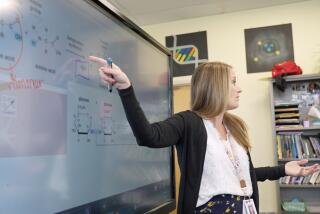Bridging the Language Gap : Students Help Each Other Amid Bilingual Teacher Shortage
- Share via
LONG BEACH — When teacher Donna Cox had conferences with the parents of her 35 fourth-graders, 29 needed translators--in three languages.
For the Signal Hill Elementary schoolteacher, this summed up the challenge she faces daily in her classroom: How to make herself understood.
Because Cox speaks only English, she must speak slowly, repeat, ask students to translate for other students and rely on an aide who speaks Spanish.
But she considers her job an interesting challenge. “In the end, you’re better off for it,” she said. “You’re richer for learning about other cultures.”
Cox is one of many teachers in the Long Beach Unified School District who face the Tower of Babel in the classroom every day. The number of students who speak limited English has doubled since the mid-1980s to 33% of the district.
And finding translators is not easy. The children speak 47 languages. Of the 24,093 children who speak other languages, 15,433 speak Spanish, 5,213 Cambodian, 903 Vietnamese, 797 Tagalog, and 449 Lao.
The district--which has never met state requirements for teaching students with limited English--nearly lost $7 million in state funds for this school year because of the shortage of qualified bilingual teachers and language development specialists.
Of the 3,786 teachers employed by the district, 125 are certificated in bilingual education. This represents a shortage of 300 teachers: 200 certified to teach in Spanish and 100 certified to teach in Cambodian.
Despite the shortage, the district persuaded the State Board of Education that it was making a good-faith effort to comply with state requirements.
“The state saw evidence of our efforts in every area of their review,” said Dorothy Harper, a district administrator. “What they’re asking for is an ideal situation, which we know we can’t accomplish right now, but we’re getting there.”
In the fall, the district will be reviewed again.
“The district has made some very positive changes in the last three years but still has a long way to go,” said Roberto Uranga, chairman of the district’s Hispanic Advisory Committee.
Schools “need to teach content areas such as science and social studies in native languages” to prevent students from falling behind, Uranga said.
The school district must also offer bilingual teachers extra pay to compete with Los Angeles Unified and ABC Unified school districts, he said. “If the district does not address this issue, they will never recruit the teachers they need.”
The district is recruiting college graduates and teacher aides who have degrees to become certified in bilingual education. This summer, the district plans to start an internship program to train bilingual teachers.
Although they do not have bilingual certificates, about 20% of the district’s faculty have received training as language development specialists.
Cox was encouraged to become a language development specialist by taking a 48-hour district course. But she says she has little time to take more courses.
And, she says, she uses a number of techniques for coping with the many languages in her classroom.
When Georgina Camarena arrived in the class from Mexico last fall, Monica Reyes translated for her. The 10-year-old girls sat side by side and spoke quietly in Spanish throughout the lessons. Months later, Georgina understands more English but still needs a peer tutor most of the day.
Cox said simultaneous translation helps students keep up with their classmates.
“Some kids rely on translators too much and act mute, but we don’t force them to speak except to say please, thank you, yes or no,” she said.
The influx of immigrants to the district may be slowing down, district administrator Martha Estrada said. In the fall, officials expected four classrooms of students who spoke little English, but only 29 enrolled, so the newcomer program at Murray Elementary School was closed.
Estrada said this may show that new immigrants no longer find Long Beach attractive. She said fewer jobs, gang violence and the riots may have discouraged people from moving to the city.
But even students who have been studying English for several years need special assistance.
Denise Anguiano, 10, like many of Cox’s students, is nearly fluent in conversational English but has trouble understanding some assignments, especially math word problems.
“I feel scared when I don’t understand some words,” said Denise, one of the top students in the class. “Then I have to raise my hand and tell Ms. Cox I don’t understand.”
Her mother, Guadalupe Anguiano, 28, volunteers 12 hours a week at Signal Hill Elementary--eight hours in her daughter’s class and four hours in her son’s first-grade bilingual class. She reads stories in Spanish or does classroom chores such as making copies. She is also secretary of the Parent-Teacher Assn. and chairwoman of the school’s Bilingual Advisory Committee.
A native of Mexico, Anguiano speaks little English but is taking classes at the school.
“I try to be as active as possible, to learn more English, so I can support my daughter in her education,” she said in Spanish. “I feel a desperation when I can’t help Denise with her homework.”
Christopher J. Steinhauser, principal of Signal Hill Elementary, said his staff has coped with the challenge of teaching the 825 students--60% of the school’s enrollment--who speak English as a second language.
“People have put their hearts and souls into learning new ways to teach these kids,” he said. “We have a big job, but there are no roadblocks. If there’s a problem, we brainstorm together and find a solution.”
The students are expected to do well in all subjects, no matter what their primary language is, he said. “It’s malarkey that you have to water down expectations because kids don’t speak English.”
Some teachers at the school celebrate Asian and Latino holidays as well as English ones, cook ethnic meals and invite parents to share their cultural histories.
During a recent social studies class, Cox incorporated her students’ backgrounds into the lesson.
“A long time ago, some members of my family came to this country from France,” she told them. “Maybe some of your family or friends are from Mexico or Cambodia or Thailand. In your group, go around the table and share where your family or friends are from.”
Gesturing as she talks, patting students on the back and nodding encouragement as they participate, Cox lists the countries: Belize, Germany, Cambodia, Thailand, Mexico, the United States. From this list, the students make a social studies game. They are encouraged to talk; a primary goal is to stimulate language development.
Cox also matches pictures with concepts and has stories read aloud in English and Spanish. Unfortunately, she said, bilingual materials are not readily available for Cambodians, Pacific Islanders, Thais and other minorities.
For the children, the cultural diversity provides added opportunities to learn. Josh Albillo, 9, a student in Cox’s class, speaks Spanish and English at home but is eager to learn more.
“My friend Terry taught me some Cambodian,” he said with a big grin. “When kids are speaking Cambodian and looking at me and laughing, I feel like they are talking about me. So that’s why it is better to learn a little bit of their language.”
Terry Som, 10, speaks Cambodian and English at home and said she feels comfortable in Cox’s class because the teacher helps all the students feel included.
“She tries to learn to speak a little Spanish and Cambodian. She wants us to correct her if she says it wrong,” Terry said. “She gets the Cambodian words wrong sometimes,” she added with a giggle.
Terry said she is beginning to understand a little Spanish. “At recess, I play almost all the time with girls who speak Spanish.”
Bringing the cultures together and building on the strengths of the students and teachers is the main focus of the school, Cox said.
“And these kids will be ahead of the game in the end,” she said. “They’ll be bilingual.”
Bilingual Programs
Long Beach Unified School District programs for students who speak limited English:
Spanish Bilingual: Kindergarten through 12th-grade classes conducted primarily in Spanish with part of the day devoted to English language development.
Cambodian Bilingual: Classes in first and third grades are taught in English, but some lessons are translated for Cambodian speakers.
Spanish Two-Way Immersion: Classes are 90% in Spanish for kindergarten and first grade, gradually decreasing to 50% by fifth grade. English speakers become fluent in Spanish, and Spanish speakers in English by fifth grade.
Language Learning: Classes conducted in English for children in kindergarten through fifth grade who speak no English or Spanish. Primary language support is provided by an aide.
Intensive Language Institute: One year of English classes for students in grades six through 12 who speak no English, with primary language support from an aide. This is a self-contained class geared to students who have not had recent schooling experience.
English Language Development: English classes for one period daily for all students who speak limited English. Daily instruction with visual aids, hands-on activities and pantomime to promote communication skills.
Sheltered Content Instruction: Classes in subjects such as science with vocabulary and instruction in English using visual aids, simple vocabulary, repetition, slower speech, group activities, games and hands-on activities. Same content as in regular classes but using simpler communication.
More to Read
Sign up for Essential California
The most important California stories and recommendations in your inbox every morning.
You may occasionally receive promotional content from the Los Angeles Times.










